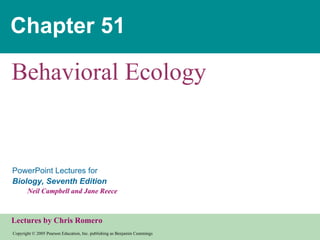Report
Share

Recommended
More Related Content
What's hot
What's hot (20)
Micro evolution,macro evolution or mega evolution ppt

Micro evolution,macro evolution or mega evolution ppt
Implications of variation adaptation and natural selection

Implications of variation adaptation and natural selection
Viewers also liked
Viewers also liked (20)
Similar to 51 behavior text
Similar to 51 behavior text (20)
OCCURENCE OF EVOLUTION.pptx how does evolution happens

OCCURENCE OF EVOLUTION.pptx how does evolution happens
Evolution of genetic variance-covariance structuer in animal.pptx

Evolution of genetic variance-covariance structuer in animal.pptx
More from Andrew McCaskill
More from Andrew McCaskill (13)
51 behavior text
- 1. Chapter 51 Behavioral Ecology
- 35. The F 1 hybrid offspring sing a song in which the length of the standard repeating unit is similar to that sung by the Chrysoperla plorabunda parent, but the volley period, that is, the interval between vibration volleys, is more similar to that of the Chrysoperla johnsoni parent. RESULTS The results of this experiment indicate that the songs sung by Chrysoperla plorabunda and Chrysoperla johnsoni are under genetic control. CONCLUSION Standard repeating unit Volley period F 1 hybrids, typical phenotype